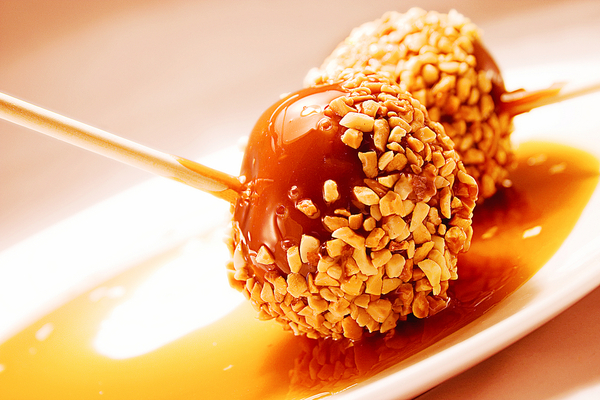As if October 31 wasn’t awesome enough with costumes, ghouls, candy, and spooky things galore – it’s also National Caramel Apple Day! Caramel apples and Halloween go together like ghosts, goblins, tricks, and treats. The tradition stretches back decades to the day a creative Kraft confectioner invented the wonderfully simple recipe while trying to figure out what to do with a bunch of excess Halloween caramels. We say, “Bravo, sir! Excellent idea!” And then we take a big, sweet, crunchy bite.
In the 1950s, a Kraft Foods employee had a plethora of caramel candies leftover from the ghoulish holiday and, apparently, a few apples as well. Figuring out a way to use up these extra caramels, the confectioner, Dan Walker, decided to melt them and covered the apples with the melted caramel, creating an immediate autumnal classic.
As fall is associated so commonly with apple picking, apple cider and caramel apples don’t fall far from the metaphorical tree. So as apple season comes to a close in late October, the remaining apples are either used to create a hot cider, apple pie, or deliciously sticky and sweet caramel apples.
It didn’t take long for caramel apples to become the official snack of hayrides and corn mazes, but it did take long for caramel and apples to become what they are today. From their advents in the Middle East to the tall tale (or fact?) of Johnny Appleseed, apples have a long history with humans. Caramel was created roughly around 1000 AD and, since then, the candies have held a firm place in the drawers of grandparents everywhere and, more recently, atop delicious apples.
Did you know…?
1. Apples in the New World. Colonists in the 1600s first introduced North America to the apples we eat and enjoy today.
2. Don’t be too crabby. The only apple native to North America is the crabapple, which most people find sour and unpleasant to eat.
3. A reverend planted the first American orchard. Rev. William Blaxton, the first colonist to settle in Boston, planted an apple orchard in 1625 — the first one on the North American continent.
4. Johnny Appleseed was real. John Chapman, better known as Johnny Appleseed, introduced apple trees to many parts of the American midwest.
5. There was once a cosmic-sized caramel ball. In 2015, Cosmos Creations of Junction City, Kansas, made the world’s largest caramel corn ball. It weighed in at a staggering 6,780 pounds.
—
Photo Credit: Olga Lyubkin / Shutterstock.com
